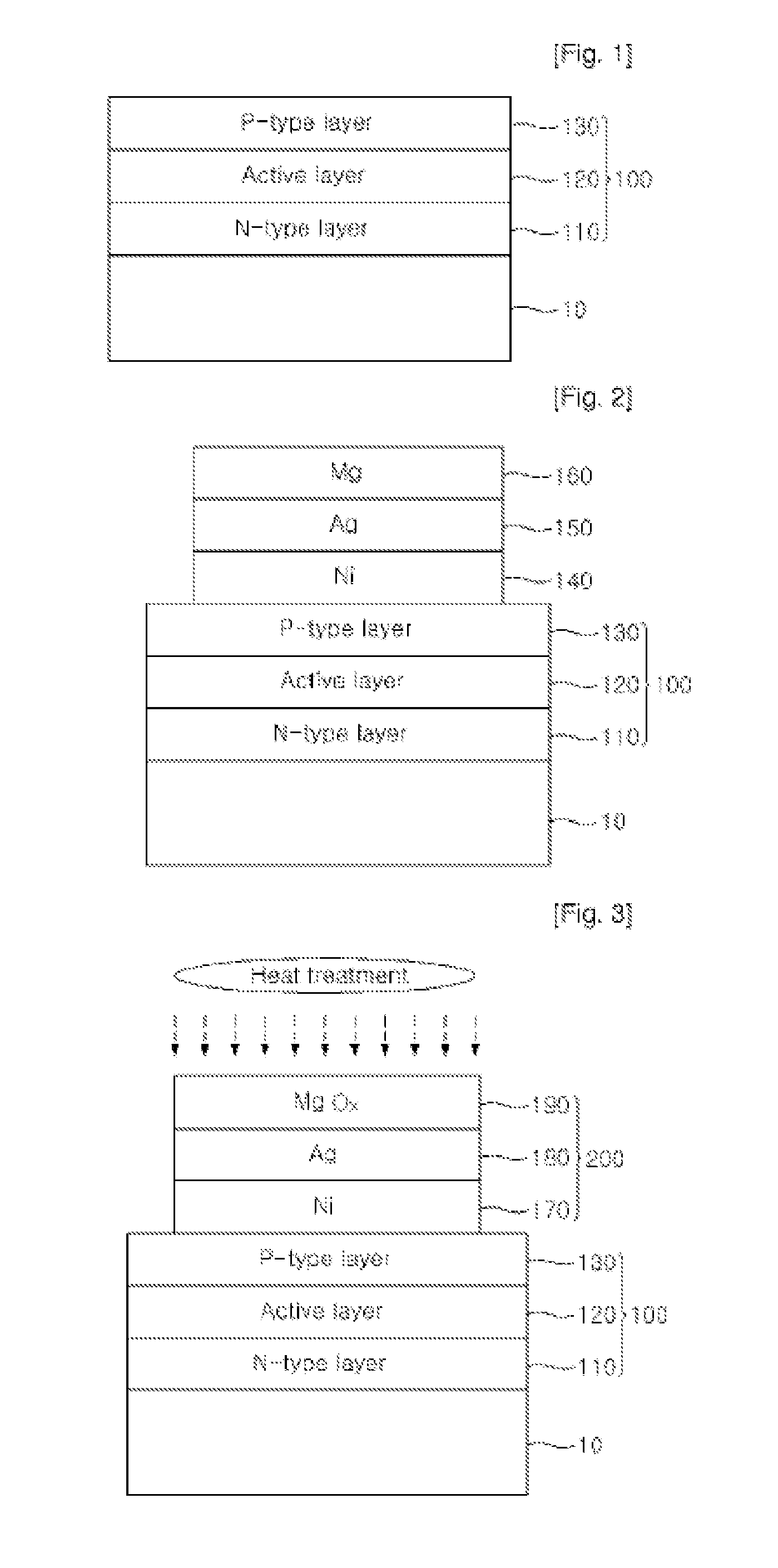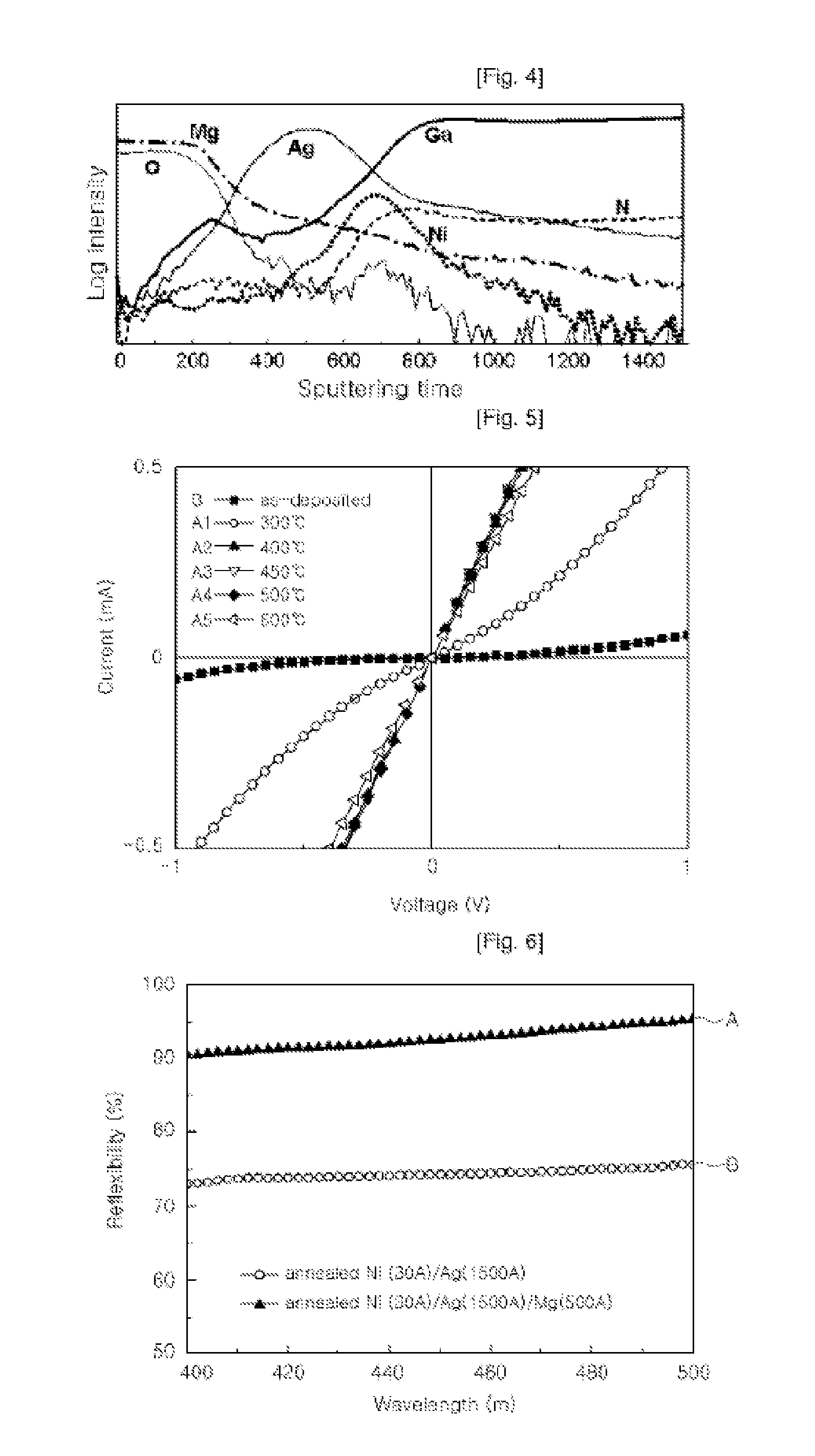Method for forming ohmic electrode and semiconductor light emitting element
a technology of ohmic electrodes and light emitting elements, which is applied in the direction of basic electric elements, semiconductor devices, electrical equipment, etc., can solve the problems of low thermal stability, difficult to implement high power, and inability to achieve high power, etc., to achieve excellent light reflectivity, suppress external diffusion of reflective layers, and enhance light availability
- Summary
- Abstract
- Description
- Claims
- Application Information
AI Technical Summary
Benefits of technology
Problems solved by technology
Method used
Image
Examples
first embodiment
[0039]FIGS. 1 to 3 are sectional views illustrating a method of forming an ohmic electrode according to the present invention.
[0040]Referring to FIG. 1, if a substrate 10 is provided, a predetermined semiconductor layer 100 is formed thereon.
[0041]The substrate 10 may be SiC, Si, ZnO, GaAs or gallium phosphide (GaP) substrate. The sapphire substrate is more preferably used as the substrate.
[0042]The semiconductor layer 100 may be formed of films including one of Si, GaN, AN, InGaN, AlGaN, AlInGaN and combinations including at least one of the foregoing. For example, in this embodiment, an n-type layer 110 is formed by implanting n-type dopants into a GaN film, an active layer 120 with a multiple quantum well structure is formed by alternately growing GaN films, as barrier layers, and InGaN films, as quantum well layers, on the n-type layer. And a p-type layer 130 is formed by growing a GaN film again and then implanting p-type dopants thereinto. At this time, a buffer layer (not sho...
second embodiment
[0060]FIG. 8 is a sectional view showing a semiconductor light emitting element with a flip-chip structure according to the present invention.
[0061]Referring to FIG. 8, the semiconductor light emitting element includes a semiconductor layer 210 with a multi-layered structure having an n-type layer 110, an active layer 120 and a p-type layer 130. The semiconductor light emitting element also includes an n-type electrode 220 formed in a predetermined region of the n-type layer 110; a p-type electrode 230 formed on top of the p-type layer 130; a submount substrate 240 connected to the two electrodes 220 and 230 using bumps 241 and 242; and a current diffusion layer 250 formed under the n-type layer 110.
[0062]The n-type layer 110, the active layer 120 and the p-type layer 130 may be formed, respectively, by depositing layers including one selected from the group consisting of Si, GaN, AN, InGaN, AlGaN, AlInGaN and combinations at least one of the foregoing. Each of the n-type and p-type...
third embodiment
[0070]FIG. 9 is a sectional view showing a semiconductor light emitting element with a vertical structure according to the present invention.
[0071]Referring to FIG. 9, the semiconductor light emitting element includes a semiconductor layer 310 with a multi-layered structure having an n-type layer 110, an active layer 120 and a p-type layer 130. The semiconductor light emitting element also includes an n-type electrode 320 formed on the n-type layer 110, and a p-type electrode 330 formed under the p-type layer 130. Here, the p-type electrode 330 includes a bonding layer170, a semiconductor layer 180 and a protective layer 190. That is, it is preferred to use the ohmic electrode described in the previous embodiment.
[0072]A method of fabricating the semiconductor light emitting element with such a configuration will be described as follows.
[0073]An n-type layer 110, an active layer 120 and a p-type layer 130 are sequentially laminated on a mother substrate (not shown) to form a semicon...
PUM
 Login to View More
Login to View More Abstract
Description
Claims
Application Information
 Login to View More
Login to View More - R&D
- Intellectual Property
- Life Sciences
- Materials
- Tech Scout
- Unparalleled Data Quality
- Higher Quality Content
- 60% Fewer Hallucinations
Browse by: Latest US Patents, China's latest patents, Technical Efficacy Thesaurus, Application Domain, Technology Topic, Popular Technical Reports.
© 2025 PatSnap. All rights reserved.Legal|Privacy policy|Modern Slavery Act Transparency Statement|Sitemap|About US| Contact US: help@patsnap.com



